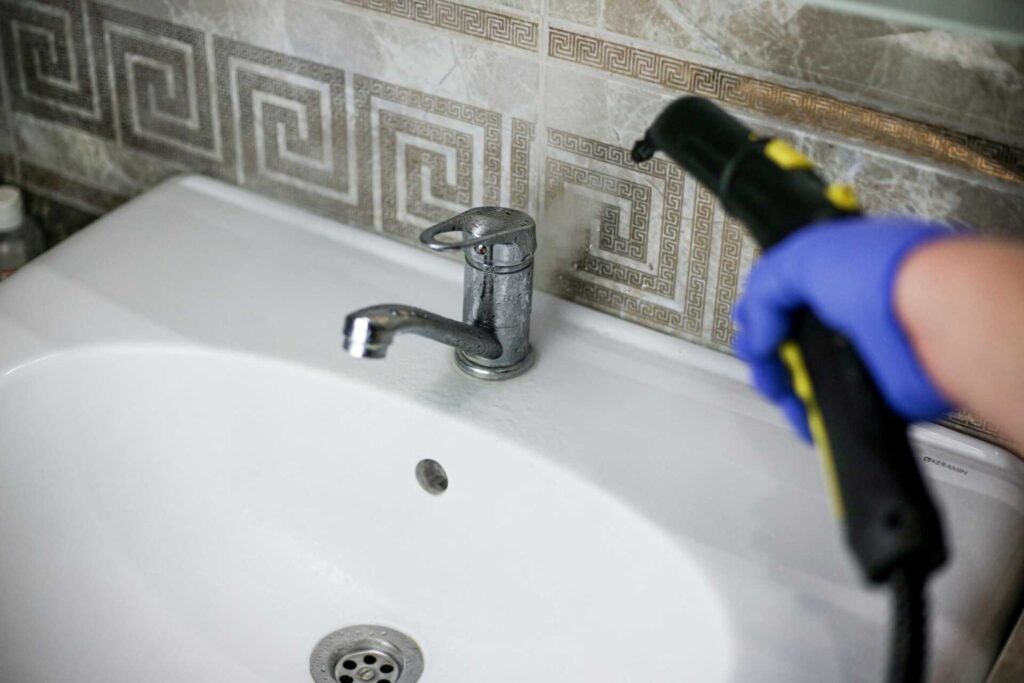
Contents
When a sewage incident occurs, it’s like a storm cloud settling over your home, threatening both safety and health. You know that swift action is vital, but understanding the right steps to take can feel overwhelming. It’s not just about cleaning up; it’s about employing advanced techniques and professional expertise to ensure thorough restoration. What if you could learn how to effectively minimize risks and safeguard your property in these dire situations? The key lies in knowing what services are essential for a rapid and effective response.
Key Takeaways
- Timely intervention minimizes damage and health risks, ensuring swift sewage cleanup and restoration.
- Advanced extraction methods, like submersible pumps and vacuum trucks, facilitate rapid sewage removal.
- Comprehensive leak detection and biohazard assessment ensure precise identification of contamination sources.
- Strict adherence to safety protocols and PPE usage protects workers during cleanup operations.
- Final inspections confirm compliance with safety standards before allowing re-entry to affected areas.
Importance of Swift Response
A swift response to sewage incidents is essential for minimizing damage and health risks. When a sewage backup or leak occurs, the clock starts ticking. Delaying action can lead to significant structural damage and create hazardous environments. You need to recognize that timely intervention is critical for protecting your property and safeguarding your health and that of others in your community.
Swift action ensures that contaminants don’t spread further into your living or working spaces. Sewage contains harmful pathogens and bacteria, which can pose serious health risks, including gastrointestinal illnesses and respiratory issues. By responding quickly, you mitigate the risk of exposure and reduce the potential for long-term health consequences.
Moreover, the longer sewage remains untreated, the more extensive the damage becomes. Flooring, walls, and personal belongings can suffer irreparable harm if not addressed immediately. Your timely intervention can make a significant difference in the overall restoration process, enabling professionals to implement effective cleanup and restoration strategies without excessive costs or labor.
In addition, a quick response fosters a sense of community resilience. When you take action, you protect your property and contribute to your neighbors’ well-being. You create an environment where everyone feels secure and valued, reinforcing the bonds that unite your community.
Ultimately, swift action in sewage incidents isn’t just about damage control; it’s about fostering a shared responsibility for health and safety.
Comprehensive Leak Detection
When it comes to extensive leak detection, utilizing advanced technology is essential for accurately identifying sources of moisture and contamination.
You’ll benefit from professional expertise that ensures precision in locating leaks and enhances overall restoration efforts.
This combination of cutting-edge tools and skilled technicians secures a thorough and efficient approach to managing sewage-related issues.
Advanced Technology Utilization
Advanced technology plays an essential role in thorough leak detection, ensuring that even the smallest leaks are identified swiftly and accurately. By utilizing cutting-edge tools, you can enhance your sewage management efforts greatly.
Here are three key components to evaluate:
Smart Sensors: These devices monitor moisture levels in real time, instantly alerting you to any unusual changes. Their precision reduces the risk of water damage and contamination.
Automated Monitoring: With this technology, you can track your sewage systems remotely. This continuous oversight allows for proactive maintenance, minimizing the chances of unexpected failures.
Data Analytics: Advanced algorithms analyze the data collected by smart sensors and automated systems, providing actionable insights that help you make informed decisions.
Embracing these advancements boosts your leak detection capabilities and fosters a sense of community among those who prioritize efficient sewage management.
Professional Expertise Assurance
Thorough leak detection requires a team of skilled professionals who understand the nuances of sewage systems and the potential risks associated with leaks.
These experts conduct extensive assessments using state-of-the-art technology and methodologies that adhere to industry standards. They don’t just look for visible signs; they employ advanced techniques like thermal imaging and acoustic listening devices to pinpoint hidden leaks that could cause significant damage.
When you engage in expert consultation, you’re not just getting a service; you’re investing in peace of mind.
These professionals analyze the existing infrastructure, identifying vulnerabilities that may lead to future problems. Their knowledge allows them to implement preventative measures, ensuring your system operates efficiently and safely.
Effective Sewage Removal Techniques
When tackling sewage removal, it’s essential to employ advanced extraction methods that ensure thorough cleanup.
You’ll need to prioritize safety precautions, as exposure to hazardous materials can pose considerable health risks.
Understanding these techniques and their implementation can greatly enhance the efficiency and effectiveness of your restoration efforts.
Advanced Extraction Methods
Efficient sewage removal relies on cutting-edge extraction methods that ensure swift and effective cleanup. By leveraging advanced equipment, you can greatly enhance extraction efficiency, ensuring that sewage is removed quickly and thoroughly.
Here are three pivotal techniques that underscore modern extraction methods:
Submersible Pumps: These powerful devices can efficiently remove large volumes of sewage from flooded areas, minimizing water damage and facilitating the restoration process.
Vacuum Trucks: Utilizing high-capacity vacuum systems, these trucks extract sewage and wastewater rapidly, making them ideal for extensive cleanup operations.
High-Pressure Water Jetting: This technique employs pressurized water to dislodge stubborn debris and blockages, enhancing the overall extraction process.
Implementing these advanced extraction methods speeds up the cleanup timeline and ensures that contaminants are effectively removed, safeguarding your environment.
With the right approach and equipment, you can achieve unparalleled extraction efficiency, securing peace of mind for you and your community.
Safety Precautions Essential
Sewage cleanup demands a rigorous approach to safety, ensuring that both workers and the surrounding environment are protected. To effectively manage hazardous material handling, you must prioritize the use of personal protective equipment (PPE). This includes gloves, masks, goggles, and protective suits, which act as barriers against harmful pathogens and chemicals present in sewage.
Before starting the cleanup process, conduct a thorough assessment of the area to identify potential hazards. Confirm that all workers are trained in proper safety protocols, emphasizing the importance of PPE and safe handling techniques.
It’s vital to maintain clear communication among team members to avoid accidents and confirm that everyone understands their roles.
During the cleanup, regularly inspect your PPE for any damage. If you notice any issues, replace the equipment immediately to maintain your safety.
Additionally, establish decontamination stations to properly clean and dispose of any contaminated gear.
Professional Water Extraction Methods
Professional water extraction methods are critical in effectively addressing sewage contamination and mitigating damage to property. When you’re faced with water damage, knowing the right techniques can make all the difference.
Here are three key methods professionals use:
Submersible Pumps: These powerful pumps are ideal for large volumes of water. They’re submerged directly into the water to remove it quickly and efficiently.
Wet/Dry Vacuums: Perfect for smaller-scale jobs, these versatile vacuums can handle both liquid and solid waste, making them essential for removing residual moisture after initial extraction.
Truck-mounted Extraction Equipment: For extensive water damage scenarios, this heavy-duty equipment provides a more robust solution. It offers high suction power, allowing for rapid extraction and reducing the risk of further contamination.
Utilizing advanced extraction equipment is crucial to ensure that any remaining moisture is eliminated, which helps prevent mold growth and further structural damage.
A well-coordinated extraction process accelerates recovery and enhances the environment’s overall safety.
Biohazard Cleanup Protocols
When dealing with biohazard cleanup, adhering to established protocols is vital for ensuring safety and compliance. Start with a thorough biohazard assessment to identify the nature and extent of the contamination. This initial evaluation helps you determine the appropriate level of protective gear required for the cleanup team and the necessary resources to manage the situation effectively.
Next, implement contamination control measures. This includes isolating the affected area to prevent the spread of harmful pathogens. Use barriers, signage, and restricted access to ensure that unauthorized individuals don’t enter the contaminated zone.
It’s essential to follow proper procedures for decontamination and disposal of hazardous materials. Equip yourself with personal protective equipment (PPE), including gloves, masks, and gowns, to safeguard against exposure.
Always ensure that your team is trained in the proper use of this equipment, as well as in the specific biohazard cleanup protocols for various scenarios.
Once you’ve contained the situation, proceed with the cleanup using industrial-grade disinfectants that are effective against the specific pathogens identified during the biohazard assessment.
After the cleanup, conduct a final inspection to confirm that the area meets safety standards before allowing anyone to re-enter.
Restoration and Repair Solutions
Effective restoration and repair solutions are vital in the aftermath of sewage contamination to restore safety and functionality to affected properties. Addressing the aftermath efficiently reduces health risks and helps you regain peace of mind.
Here are three significant aspects to take into account:
Assessment and Planning: A thorough evaluation of the damage is essential. Professionals will identify contaminated areas and structural weaknesses, creating a detailed plan for restoration.
Restoration Timelines: Timeliness is key. An effective restoration plan outlines the expected timelines based on the severity of contamination. Typically, quicker responses lead to shorter restoration periods, which minimizes disruption to your life.
Repair Costs: Understanding repair costs upfront helps you budget appropriately. Various factors influence these costs, including the extent of damage, materials required, and labor involved. Transparent pricing from restoration experts ensures you’re never caught off guard.
Once the assessment is complete and a restoration plan is in place, skilled technicians will commence repairs, focusing on sanitization and structural integrity.
This process may involve removing contaminated materials, repairing plumbing issues, and ensuring that all surfaces are safe for use.
Recap
Swift sewage cleanup and restoration services aren’t just a luxury; they’re a necessity for safeguarding your health and property. When you act quickly, you mitigate immediate risks and lay the groundwork for long-term resilience. Think of it as a shield against future hazards—one that keeps your environment safe and secure. By choosing professional services, you ensure a thorough cleanup and restoration, protecting your space and peace of mind.
Recent Posts
5 Tips for Inexpensive Leak Detection Services
It is important to promptly address any water leaks, but you don’t have to break
Mastering Biohazard Sewage Cleanup Techniques
Is it really worth the risk to tackle biohazard sewage cleanup without the right techniques?
Top Leak Detection Services for Homeowners
Is it true that most homeowners underestimate the impact of undetected leaks? You might think

